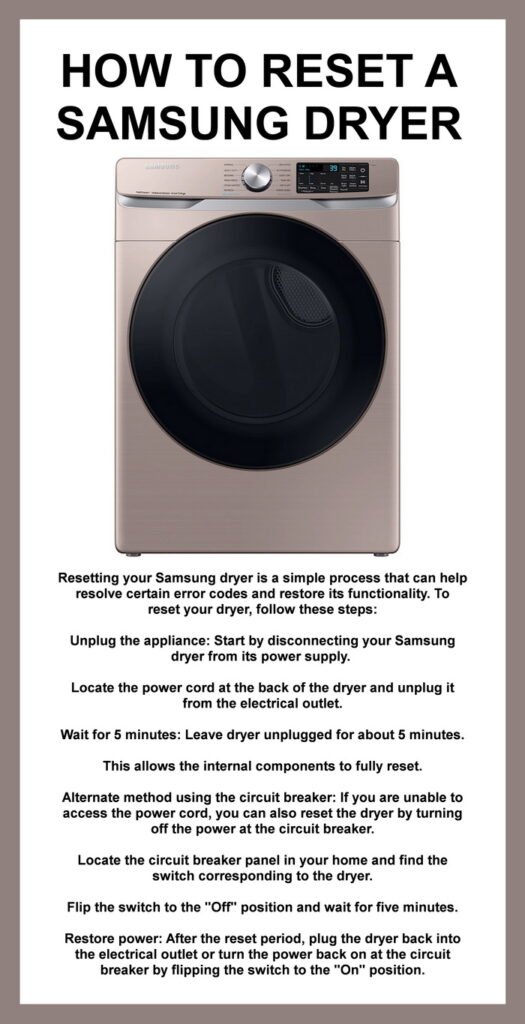
Let’s face it, dealing with error codes can feel like trying to crack a secret code. It’s frustrating especially when you just need your dryer to work. But here’s the good news—the fix is often simpler than you think! By understanding why this error appears and knowing how to tackle it, you can get your Samsung dryer back in working order without having to call in reinforcements or spend money on unnecessary repairs. Ready to dive into the details and become the hero of your own laundry room? Let’s get started.
Understanding Error Code SE
Error codes are like your dryer’s way of sending you a text about its feelings. The “SE” code in particular is related to the sensor errors—think of it as your dryer’s way of saying, “Hey, something’s up with my moisture sensors!” These sensors play a crucial role in the drying process. They monitor the moisture level within the drum, telling the dryer when your clothes are perfectly dry. If these sensors aren’t working correctly, your dryer might not turn off, or it may stop prematurely, leaving you with damp laundry.
So, what causes this mishap? There are a few possibilities. Sometimes, it’s just a matter of too much lint or residue build-up on the sensors themselves. Just like that gunk that accumulates on your shower head, this build-up can interfere with the sensors’ ability to function correctly. Other times, it might be an electrical glitch—a random hiccup in the system that throws everything off balance. And in some cases, the issue might be a wiring fault or a problem with the control board.
Before you start worrying about all the potential technical issues, note that many of these problems have simple solutions. Often, a reset—a kind of “turn it off and back on” approach—can resolve these anomalies. It’s important to remember that while the “SE” error might seem daunting, it’s usually something you can handle on your own with a bit of guidance.
Steps to Reset Your Samsung Dryer
Alright, let’s get to the main event: the reset itself. Think of this process as giving your dryer a fresh start, much like rebooting a slow computer. Before you begin, ensure the dryer is off. You wouldn’t want to mess with electronic settings while the machine is running. Start by unplugging the dryer from the power outlet. This step is crucial because it ensures no electricity is flowing through the system while you perform the reset.
Now that your dryer is safely unplugged, wait for about five minutes. This pause allows the internal electronics to fully discharge and reset themselves. It’s like letting your brain reset after a nap. After this waiting period, plug the dryer back into the outlet. You’re essentially jump-starting the dryer’s systems to see if they’ll behave better now. Go ahead and turn on the dryer to see if the error code has vanished. If everything went smoothly, the “SE” code should be gone, and you can run a test cycle to ensure the dryer is back to its usual self.
If the error persists despite the reset, don’t panic. It might mean there’s a deeper issue that needs addressing, like a sensor replacement or a professional inspection. But in most cases, this basic reset should do the trick and restore your dryer’s functionality.
Preventing Future Errors
Now that your dryer is hopefully up and running again, let’s talk about keeping it that way. Regular maintenance is key to preventing that pesky “SE” error from popping up again. Just like how you’d clean a car’s windshield to keep it clear, the moisture sensors in your dryer need a bit of love too. After every use, make it a habit to wipe down the drum and sensors with a soft cloth to remove any lint or residue build-up. This simple act can help maintain sensor accuracy and ensure your dryer runs seamlessly.
Beyond cleaning, consider clearing the lint trap and vent regularly. A clogged vent can affect the dryer’s performance as a whole, leading to potential errors cropping up. It’s a bit like what happens when you try to breathe through a straw—extra work for less output. Also, avoid overloading the dryer, as this can strain the sensors and other parts, leading to frequent hiccups.
If you start encountering frequent errors even after regular maintenance, it might be time to consult the pros. Sometimes, underlying issues with internal components might not be visible or fixable through DIY means. Regular professional check-ups can help nip potential problems in the bud, keeping your dryer in peak condition.
In conclusion, while the “SE” error can be a nuisance, with a little patience and care, you can manage and even prevent it. Here’s to many more loads of clean, dry, and fresh laundry!